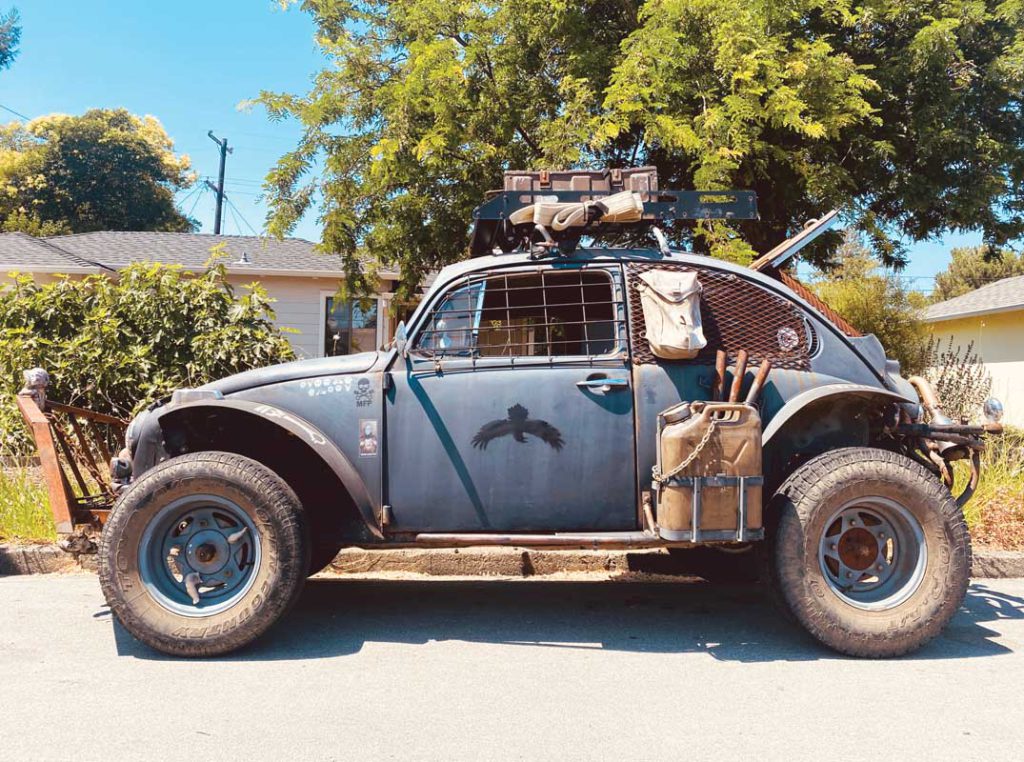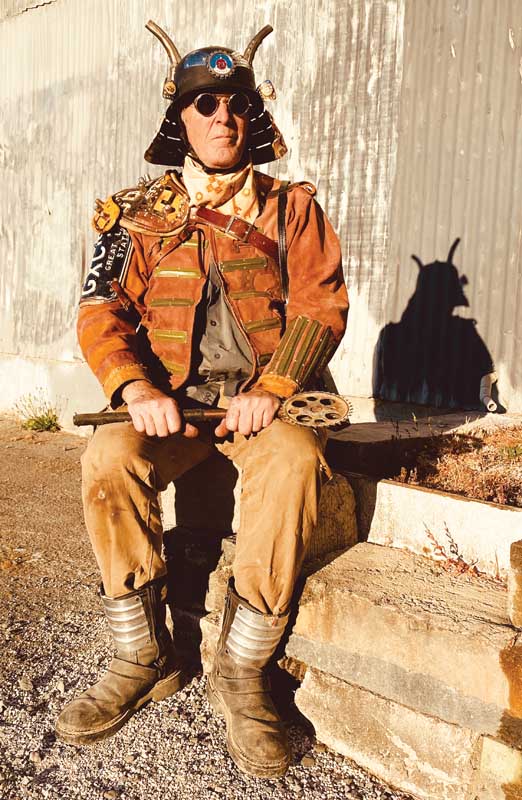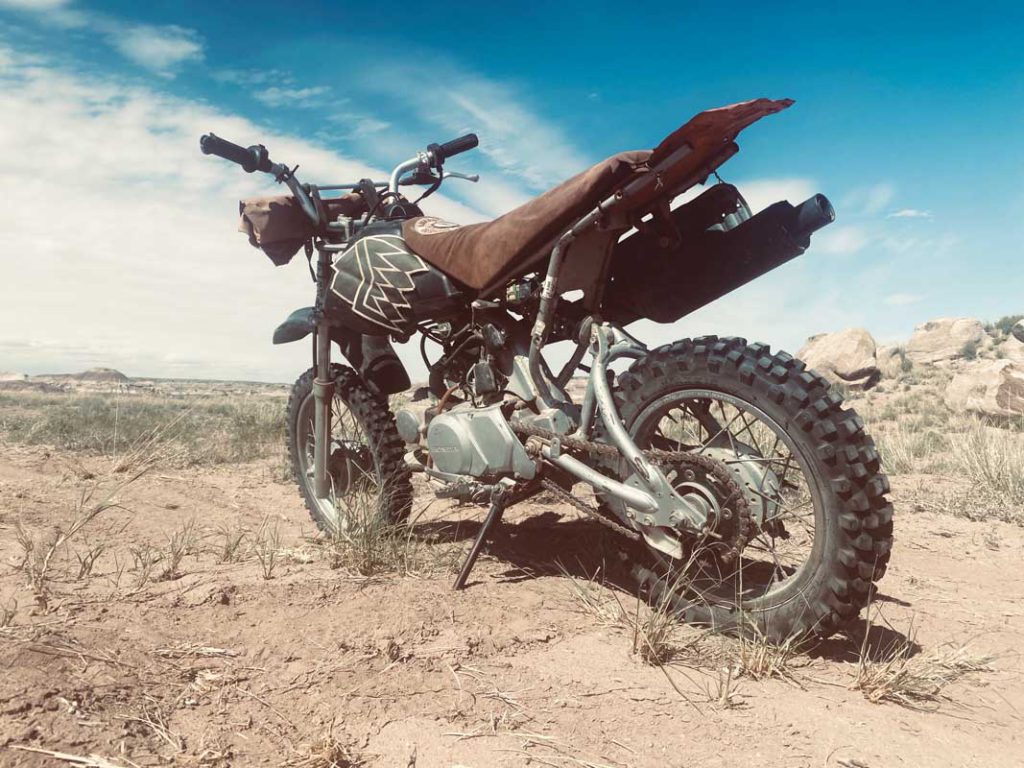A new subculture has been quietly brewing worldwide for the past 15 years, and it’s arrived in a town nearby.
Its adherents, known as wastelanders, ascribe to a creative aesthetic primarily influenced by the post-apocalyptic Mad Max film franchise, and their scene is unofficially known as the wasteland scene.
The wasteland scene, named loosely after Wasteland Weekend, the yearly event that bonds wastelanders into a somewhat-cohesive group, finds its roots with the release of the first, self-titled Mad Max movie in 1979, and has gained steam ever since. With Mad Max, director and “mastermind” George Miller kicked off an epic saga that includes, in addition to the aforementioned movie, The Road Warrior (1981) and Mad Max Beyond Thunderdome (1985), Fury Road (2015) and Furiosa (2024).
Together, the five films span 45 years in realtime and about the same in movietime—long enough for the industrial world to sputter and stop, and for a new, scrappy world to emerge in its bleak wastes.
Within the ochre-hued Australian Outback, reluctant hero and ex-cop Max Rockatansky, and in later movies, Imperator Furiosa, encounter a rogue’s gallery of leather-clad desperados whose hardscrabble scramble for survival drives them to battle each other on the world’s last roads in smoke-spewing, supercharged war machines at 90 miles per hour.
In the ruined landscape of tomorrow, cars symbolize power, and gasoline is far more precious than water. In its simplest form, the wasteland is today’s equivalent of the Wild West, with motorcycles and gasoline replacing horses and water, and marauders replacing bandits. Freedom, adventure and giddy lawlessness remain its most basic attractions.
Importantly, the wasteland, though bleak and unforgiving, is also beautiful in its own way, filled with costumes and vehicles exquisitely hand-crafted out of priceless recycled Old World detritus. A highway sign becomes a prized shield, camera lens parts become goggle eyepieces, and a toilet seat and an exhaust pipe become a flame-throwing guitar. As creator George Miller himself once said, “Just because it’s a wasteland doesn’t mean that people don’t make beautiful things.”
Wasteland Weekend
In 2009, the first Wasteland Weekend event took place, in California’s Mojave desert. A handful of people attended. By the time I found my way there in 2012, about 500 people showed up. The event, held a mile or so off a potholed highway-to-nowhere near Edwards Air Force Base, exuded the raw artistic vibes of an underground pop-up punk party. I instantly fell in love with it.
When Fury Road debuted in 2015, after a three-decade delay, interest in the franchise—and Wasteland Weekend—exploded. A new, younger generation of post-apocalyptic aficionados emerged, and the term “wastelander” gained general acceptance in the community.
Now in its 15th year, with its own festival site located near California City, an estimated 5,000 attendees descend upon Wasteland Weekend every September. For five brutally hot, dusty days, they inhabit a themed, pop-up “Wasteland City” in post-apocalyptic costumes, bartering homemade goods, hitching rides on soot-spewing hot rods, dancing to live music at the free Wreck Room lounge and other venues and, importantly, earning their “wasteland” names. Many form tribes, reconnecting with their “dirt family” at each event.
People journey from across the globe to attend the event, though the majority of attendees live in the United States, and most of those in California. Roughly 20 reside in Sonoma County. In late May, the Sonoma clan gathered at Santa Rosa’s Airport Stadium 12 movie theater to watch the latest Mad Max movie, Furiosa. I later interviewed several of them for this article.
‘Dogtown’
Randle “Dogtown” Moore, 55, of Santa Rosa, is not the average wastelander—but who is? No two wastelanders are alike, and that’s kind of the point. The wasteland scene is a space for crafters, scoot-jockeys, survivalists and movie fanatics to let loose with their creativity, each in their unique way.
On a recent Thursday, I caught up with Dogtown in his backyard workshop. A gifted artist, he began attending Wasteland Weekend in 2019. He hooked up with a Sacramento tribe called the Dead Crows for a few years, but plans to switch things up this September. “I’m taking a sabbatical for a year, and I’m building my own camp, doing my own thing,” he said. “A juke-joint-’50s-soda-bar-sock-hop place.”
Dogtown plans to showcase “swing, blues, all that old-timey stuff”—with some vintage punk music thrown in—and is designing portable walls which he will wallpaper with laminated punk band fliers. He even managed to obtain a case of old-time Moxie soda for the bar. His current project? Configuring an antique jukebox to hold all the songs.
Dogtown’s Mad Max roots date back to junior high in the early ’80s, when his brother-in-law took him to see The Road Warrior. He liked the movie so much he brought his friends to see it. “We played D&D (Dungeons & Dragons); we were role players,” he said. “So I took the game system rules and applied it to the Mad Max world, and we started playing what we called Road Warrior, which was a post-apocalyptic D&D-style game.”
A few years later, they formed a punk biker “gang” and rode around sporting movie-accurate “MFP” (Main Force Patrol) police patches on their jackets. Dogtown still owns his original denim vest, which he upgraded with fur and hand-painted artwork and now wears in the wasteland.
These days, he creates and sells patches and candles deifying the Mad Max movie characters. He’s also working on a tome of sorts, a leather book filled with colored drawings of the Mad Max characters and their pithy quotes.


But perhaps Dogtown’s most eye-catching wasteland creation is the Battle Bug, a ’65/’73/’79 VW Beetle in need of such repair when he bought it that he rebuilt it using parts of three different Bugs. After considerable work, it now boasts a roof hatch, a cowcatcher, all-terrain tires and armored window screens. Sometimes, when strangers approach him at Wasteland Weekend to tell him how cool it is, Dogtown tosses them the keys and tells them to take it for a spin.
‘DeathstarSamovar’
Kimric Smythe, 62, of Petaluma, arrived in the wasteland via a cosmically convoluted path. After a childhood split between Pakistan, Somalia and Santa Cruz, and following a stint in the Air Force, he arrived in San Francisco in the late ’80s. There, he hooked up with numerous underground art scenes, including the legendary Cacophony Society and Survival Research Labs (SRL).
An inventor and tinkerer by nature, Smythe wore many hats over the years, some official—doing quality assurance for a tech company, making costumes at a costume company, studying solar and alternative energy—and some decidedly unofficial, like assisting with the construction of giant destructive robots and serving as the de facto fireworks guy for Burning Man in its early years.
“I would wear nine pounds of fireworks on giant pinwheels, and do these performances,” he said, adding that he still coordinates large-scale art installation demolition-burns at Black Rock City.
When Burning Man grew too large for Smythe’s liking, he gravitated to the steampunk scene before entering the wasteland in 2015. For the last 30 years, he’s owned Smythe’s Accordion Center, now the last accordion repair/sales shop in the Bay Area, but he also sells handmade functional armor, made out of street signs, in his Etsy store, DeathstarSamovar.
“Everything’s fucking riveted by hand,” he told me when I visited his house, gesturing towards a box of armor pauldrons. “There’s no plastic. I even dye and stain the fabric before I do the padding.” He described how he hammers the rivets out of metal game tokens and uses antique leather accordion straps and buckles from the ’30s and ’40s, adding, “I do custom work, too.”


Several years ago, Smythe helped fabricate a motorized wasteland-mobile out of street signs, and both he and it are now familiar sights at Wasteland Weekend and other events.
But by my estimation, Smythe’s most intriguing creation is the homemade portable air-conditioning unit sitting on his living room table. It fits inside a vintage, Flipper-blue tool-box-cum-backpack. Under his direction, I started the mysterious unit with the flick of a switch and waited for it to begin blowing warm air out of its tiny exhaust pipe. Then I donned a hand-fabricated vest lined with plastic medical tubing, strapped the backpack to my back and connected its tubing to the vest’s … and proceeded to cool down.
My only thought was: I could be king of the wasteland. I removed the entire contraption and left Smythe’s house with his parting words ringing in my ears: “The batteries last six to eight hours.”
‘Rad Max’
If ever anyone was born to be a wastelander, surely it is Max “Rad Max” Braun, 32, of Santa Rosa, whose father actually named him after the eponymous movie character himself, “Mad” Max Rockatansky. Rad Max made his first Mad Max costume in fourth grade, out of cardboard and duct tape, because he couldn’t find any black leather garments that fit him. Then he stepped his game up and in 2015, with the release of Fury Road, made his first real costume.
Cosplay runs in Rad Max’s veins. “I really like the costuming,” he said. “I wish Wasteland [Weekend] was the only fandom I invested a bunch of time and effort in, but I also do Halo costuming, Star Wars, Red Dead … a little bit of everything.”
As I photographed him in a warehouse during our interview, he described how he ages fabrics, creates faux-metal out of plastic, and makes faux-leather out of foam rubber and fabric to produce a wasteland look. But his wasteland revolver, welded out of scrap metal and bullet shells, took the cake for sheer ingenuity.
Rad Max’s devotion to the wasteland scene verges on legendary—and not just because of his screen-accurate costumes for all five Mad Max movies, including three versions for Fury Road alone. He also lives in a wasteland household, with his wastelander wife and two other longtime wastelander friends.
Their first year at Wasteland Weekend, in 2017, they formed their viking-themed, post-apocalyptic tribe called Children of Aesir, which counts 8-10 members at any given time. They built a portable wooden longhouse, which they transport to Wasteland City and assemble on-site each year.
“We’ve invested in trucks and trailers and storage,” he said. “We also drive in a convoy.”
He added, “I always bring a Mad Max costume every year. There’s probably a good amount of people [at Wasteland Weekend] that haven’t seen the movies. They’re either Burners or just festival goers. And I want to keep that spirit alive.”
This past May, Rad Max attended a Furiosa pre-screening at San Francisco’s AMC Metreon 16 IMAX theater with 30-odd other costumed wastelanders and a crowd of influencers and reviewers. As Rad Max tells it, one reviewer described the wasteland contingent as a scary, intense group of people who yelled and screamed and riled up the crowd. But as soon as the movie started, they transformed into the quietest and most respectful members of the audience.


End Game
Rumors abound that George Miller, now 79 years old, may yet direct one more Mad Max movie. The screenplay exists, and its title is, take a wild guess: The Wasteland.
My fellow wastelanders and I hope Warner Bros. greenlights the project. If and when The Wasteland’s release date is ever announced, we’ll all count the days till we can watch it on the silver screen.
But regardless, the epic Mad Max saga already contains enough post-apocalyptic inspiration to fuel the wasteland scene into the foreseeable—and dare I say post-apocalyptic?—future. New wasteland events keep popping up all across the United States, and in Europe and Australia. But that is a story for another day.
Perhaps Rad Max summed up the wasteland scene best when he said, “It’s a way of life for wastelanders, where it’s gone past the movies, and now we do our own thing.”












sad
Why sad? Lol
It’s the new Rennaissance Faire.
Good article I can taste the dirt and the sting of the wind.
Well-written and nicely done! See you in the dirt! 🙂
Heck yeah